06.130.F122: Tile Floor Adhered to Concrete Substrate
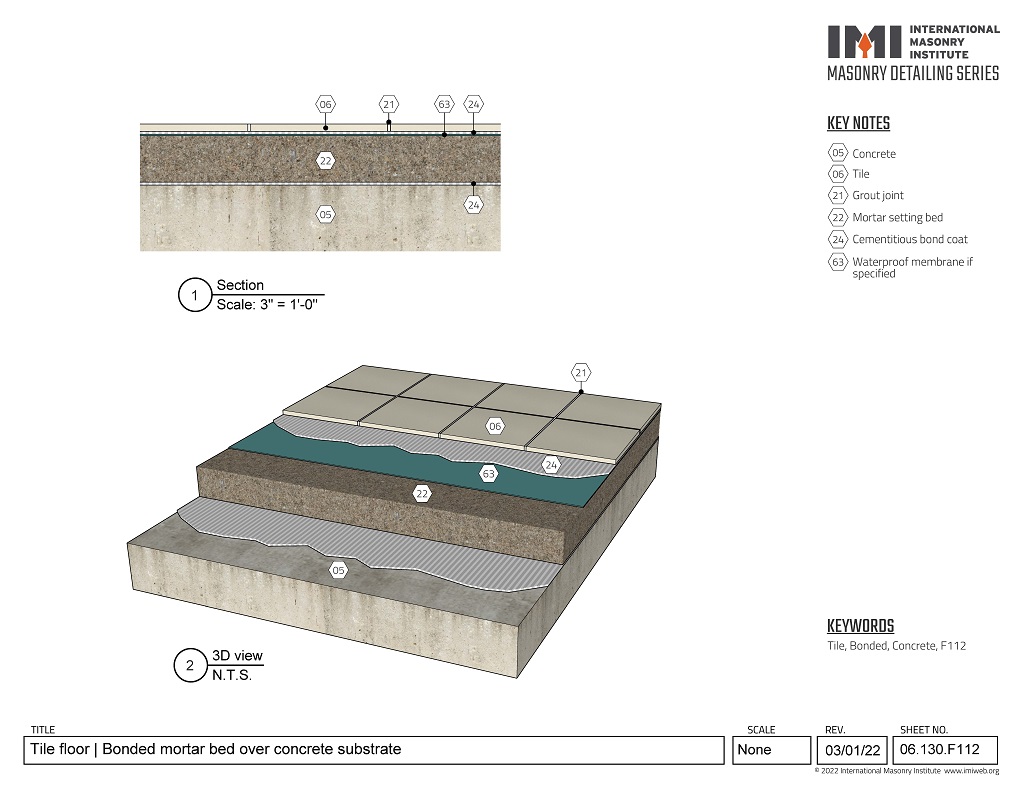 06.130.F122: Tile Floor Adhered to Concrete Substrate This detail shows ceramic or stone tile adhered to a concrete substrate with a cementitious bond coat. If specified, a compatible waterproof membrane may be applied over the concrete. Expansion joints in the floor assembly must be provided at locations shown by the design professional. This detail is [...]
06.130.F122: Tile Floor Adhered to Concrete Substrate This detail shows ceramic or stone tile adhered to a concrete substrate with a cementitious bond coat. If specified, a compatible waterproof membrane may be applied over the concrete. Expansion joints in the floor assembly must be provided at locations shown by the design professional. This detail is [...] 06.130.F112: Tile Floor Bonded Mortar Bed Over Concrete Substrate
 06.130.F112: Tile Floor Bonded Mortar Bed Over Concrete Substrate This detail shows ceramic or stone tile on a bonded mortar bed over a concrete substrate. The mortar setting bed is bonded to the concrete with a cementitious bond coat. The tile may be fresh-set (i.e. the mortar bed is still workable) and adhered to the [...]
06.130.F112: Tile Floor Bonded Mortar Bed Over Concrete Substrate This detail shows ceramic or stone tile on a bonded mortar bed over a concrete substrate. The mortar setting bed is bonded to the concrete with a cementitious bond coat. The tile may be fresh-set (i.e. the mortar bed is still workable) and adhered to the [...] 04.130.0206: Stone Floor Adhered to CBU Over Wood Substrate

This detail shows 2 cm (3/4 in.) thick dimension stone adhered to cementitious backer units (CBU) over a wood substrate with a cementitious bond coat. The CBU underlayment is adhered and mechanically fastened to the plywood subfloor. Expansion joints in the floor assembly must be provided at locations shown by the design professional. This detail […]
04.130.0204: Interior Stone floor With Unbonded Mortar Bed Over Wood Substrate

This detail shows 2 cm (3/4 in.) thick dimension stone on an unbonded mortar bed over a wood substrate. The mortar setting bed is separated from the wood with a cleavage membrane to allow the stone assembly to move independent of the structure. The stone is typically fresh-set (i.e. the mortar bed is still workable) […]
04.130.0203: Stone floor With Unbonded Mortar Bed Over Concrete Substrate
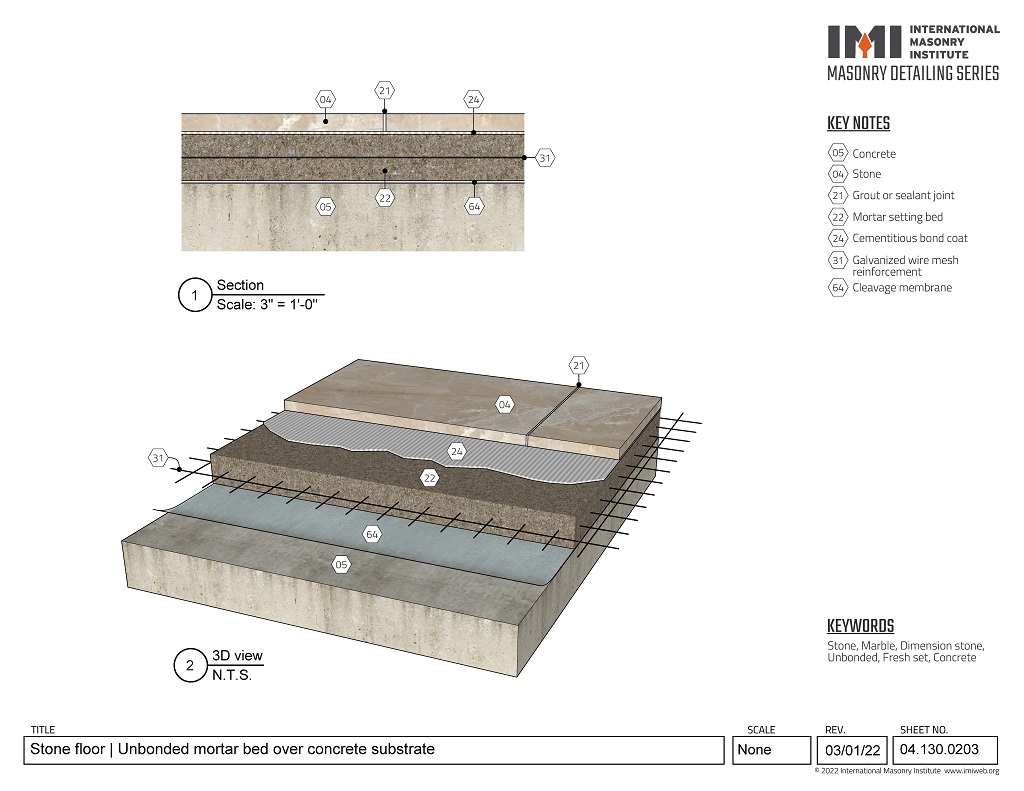
This detail shows 2 cm (3/4 in.) thick dimension stone on an unbonded mortar bed over a concrete substrate. The mortar setting bed is separated from the concrete with a cleavage membrane to allow the stone assembly to move independent of the structure. The stone is typically fresh-set (i.e. the mortar bed is still workable) […]
04.130.0202: Stone Floor Adhered to Concrete Substrate (Interior or Exterior)
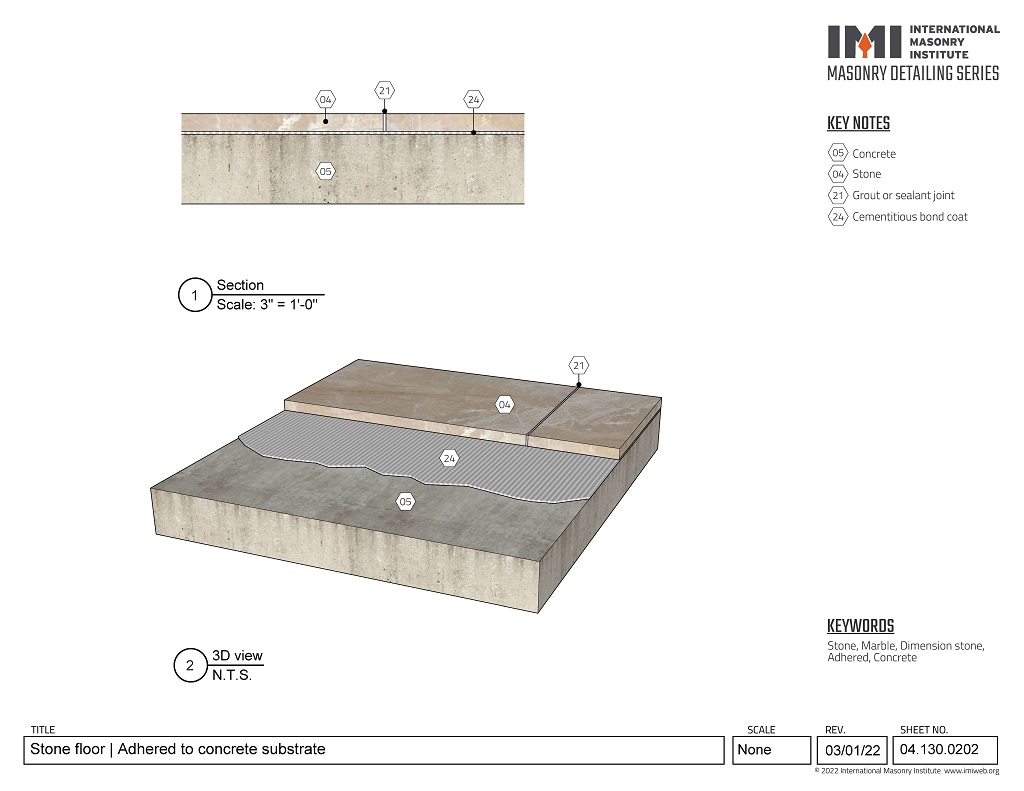
This detail shows 2 cm (3/4 in.) thick dimension stone adhered to a concrete substrate with a cementitious bond coat. Expansion joints in the floor assembly must be provided at locations shown by the design professional. This detail is based on Natural Stone Institute’s exterior stone paving detail, Mortar Bed with Thinset. Details that show […]
04.130.0201: Stone Floor With Bonded Mortar Bed Over Concrete Substrate
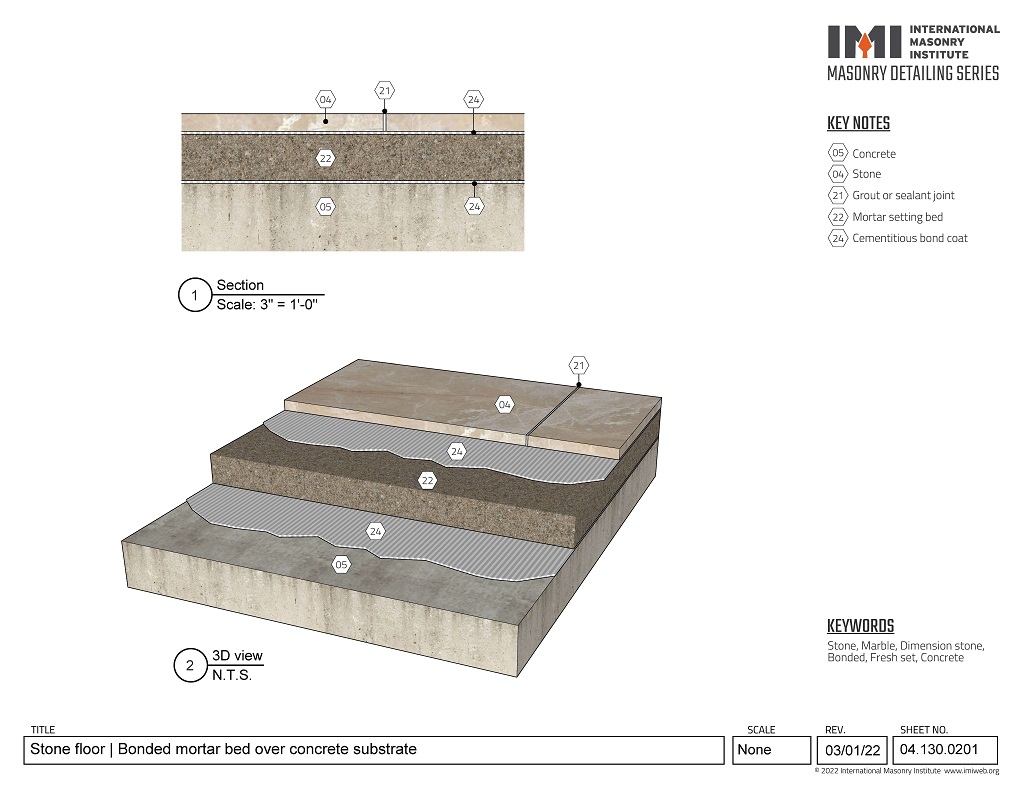 04.130.0201: Stone Floor With Bonded Mortar Bed Over Concrete Substrate This detail shows 2 cm (3/4 in.) thick dimension stone on a bonded mortar bed over a concrete substrate. The mortar setting bed is bonded to the concrete with a cementitious bond coat. The stone is typically fresh-set (i.e. the mortar bed is still workable) [...]
04.130.0201: Stone Floor With Bonded Mortar Bed Over Concrete Substrate This detail shows 2 cm (3/4 in.) thick dimension stone on a bonded mortar bed over a concrete substrate. The mortar setting bed is bonded to the concrete with a cementitious bond coat. The stone is typically fresh-set (i.e. the mortar bed is still workable) [...] 06.130.F144: Tile Floor Adhered to CBU Over Wood Substrate
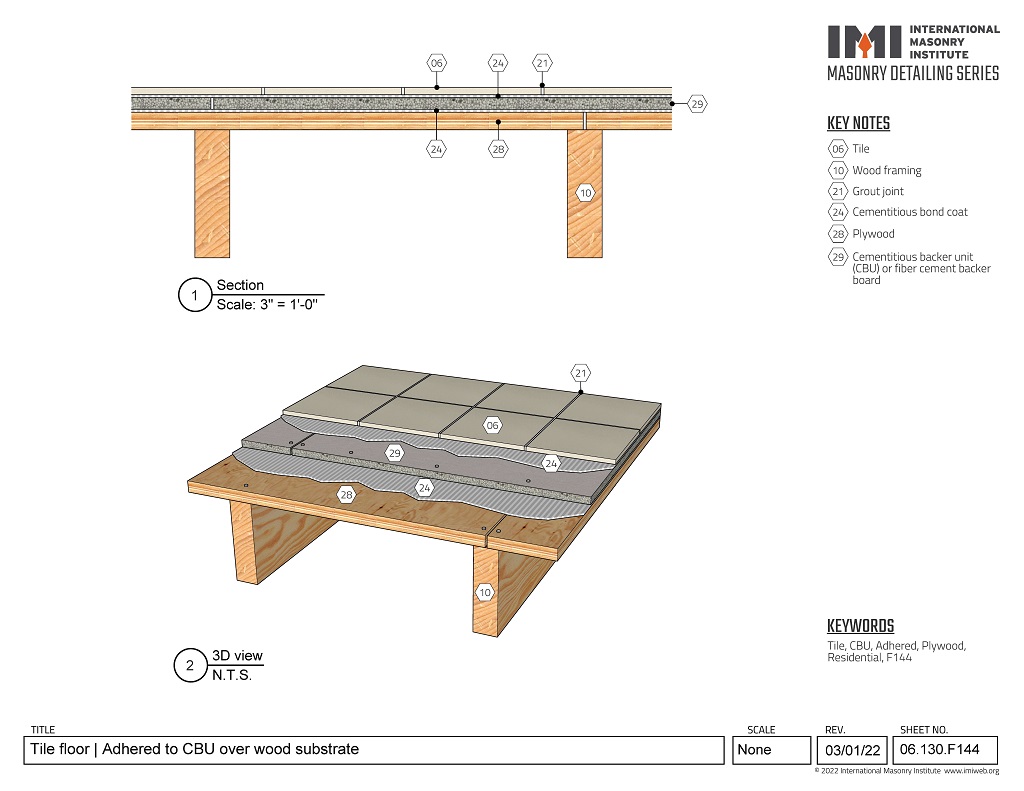
This detail shows ceramic tile adhered to cementitious backer units (CBU) over a wood substrate with a cementitious bond coat. The CBU underlayment is adhered and mechanically fastened to the plywood subfloor. Expansion joints in the floor assembly must be provided at locations shown by the design professional. This detail is based on the Tile […]
01.030.0605: Window Head | Brick Veneer, CMU Backup, Precast Concrete Lintel

3D Detail Explore this 3D detail and download the Sketchup model in the 3D Warehouse.
01.090.0600.2D Window Details | Adhered Brick Veneer, Wood Stud Backing
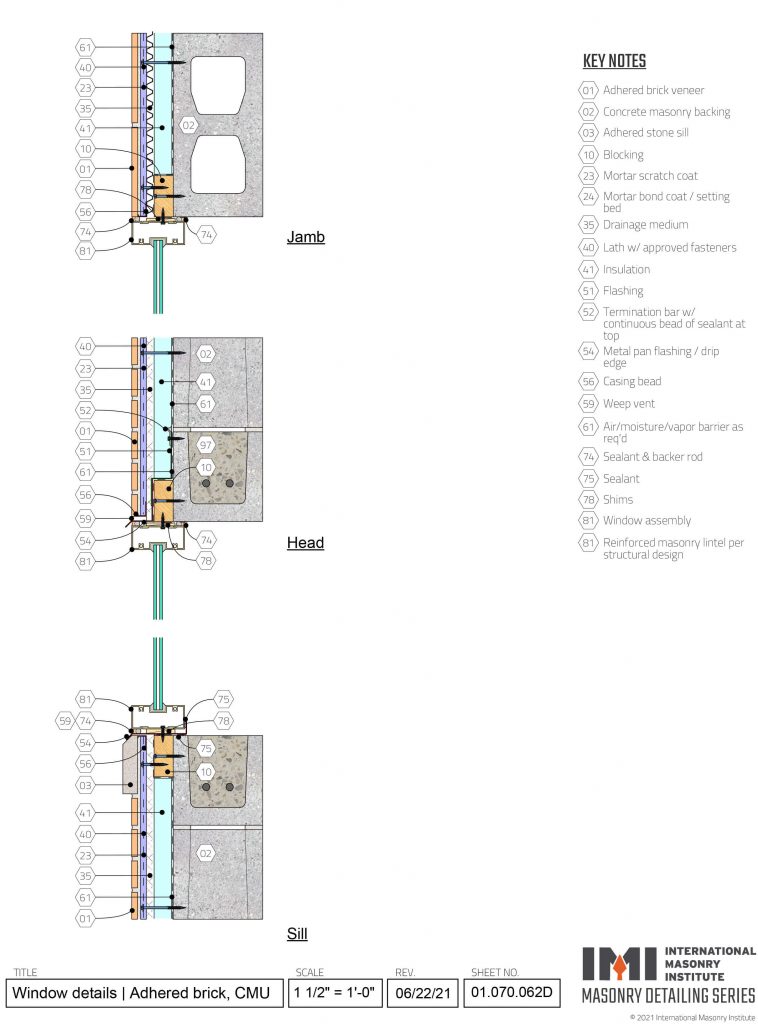
This series of 2D details illustrates a sections through a window sill, jamb, and head conditions in an adhered veneer wall with wood stud backing and glass mat reinforced exterior gypsum sheathing. This backing system represents a lower initial cost alternative to concrete masonry, giving up some of the durability, stiffness, low maintenance, and life […]
